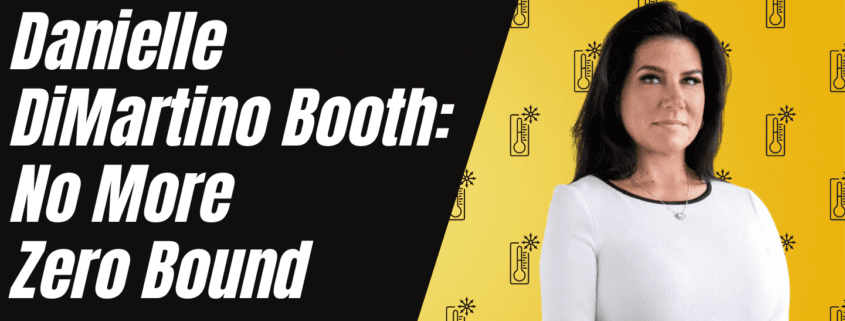Danielle DiMartino Booth: No More Zero Bound
Danielle DiMartinoBooth of Quill Intelligence is back to discuss important economic indicators and their potential impact on the financial markets. Danielle highlights concerns about the rising unemployment rate signaling a recession, why the stock market remains high, and the flight to safety trade into T-bills. Danielle also expresses skepticism about CBDCs, gives arguments for owning gold, and her odds on the likelihood of a Powell coup.
Additional Resources
Earn a yield on gold, paid in gold
The Case for Gold Yield in Investment Portfolios
Podcast Chapters
[00:00:00]: Danielle DiMartino Booth
[00:00:19]: Unemployment Rate
[00:02:29]: Recessions
[00:04:23]: Impact of Higher Interest Rates
[00:05:26]: Comparison with 2008
[00:07:34]: Interest Rate Cuts
[00:08:24]: Inflation and Deflation
[00:09:21]: Gold’s Performance and Market Fluctuations
[00:10:29]: Flight to Safety and Treasury Bills
[00:11:40]: Impact on Stock Market
[00:12:50]: Impact on Average Joe
[00:14:08]: Banking Sector
[00:15:48]: Mark-to-Target Accounting
[00:16:32]: IT’S QE!!!!!
[00:17:52]: Where to get data
[00:19:42]: Powell Coup
[00:22:28]: CBDC
[00:24:07]: Displace the Dollar?
[00:25:23]: Quill Intelligence
[00:26:05]: Subscribe!
[00:26:11]: Passive Income in Gold
Transcript:
Welcome back to The Gold Exchange Podcast. We’re coming at you live from New Orleans Investment Conference. I’m joined by Danielle DiMartino Booth of Quill Intelligence. Danielle, how are you today?
Danielle DiMartino Booth:
Great to be here with you today. It’s a nice, busy day in New Orleans, isn’t it?
Ben Nadelstein:
Absolutely. Let’s jump into the numbers. So today we’ve got the unemployment print, 3.9 %. Now we had a low of 3.4 %. Do you think that this is starting to rise in unemployment? Is that an actual structural issue we’re going to see in the coming days?
Danielle DiMartino Booth:
So it’s funny. It depends on which academic you ask. All the years that I was at the Fed, my mentor, he always said, 0.3 percentage points before you get to an inflection point in a cycle. There’s also something that’s called the SOM rule, and it’s a little bit more difficult to cross that threshold. It’s 0.5 % increase in the unemployment rate of that low. So as of this morning’s data, we have arrived. And so everything that we know historically, whether you look at a more lenient way of looking at the unemployment rate or where we are today, we’re in recession. And that is typically your unemployment rate goes up after you’re already in recession. In other words, what was GDP going into in December of 2007? When we went into the Great Finitra, GDP was 4.9%. What was GDP when we were double dipping in 1981? Because people forget that prior to the great recession, the great financial crisis, the worst recession in US history, besides the Great Depression, had been the double dip recession of 1980 and 1981. Where was GDP when we entered that? That recession, 4.3%. My point is we typically have a very robust GDP print like we did for the third quarter, 4.8%, as we’re already in recession.
That is exactly what the unemployment rate now has come back and validated.
Ben Nadelstein:
Lots of people have said, Okay, we see 5% interest rates. We’re going to see havoc in the markets. We’re going to see falling stocks, bond prices going incredibly insane, and of course now unemployment. Where do you actually see that argument in terms of the recession? Do we see stock markets follow that recessionary pattern?
Danielle DiMartino Booth:
I think what we’re going to see, and people have to understand the order of things, in 2018, J. Powell was prompted to pivot after Halloween of 2018, when the debt of General Electric was downgraded. So then we ended up starting November the 14th of that year with 41 days with no issuance. Credit markets feed into equity markets. It’s simply the way that cycles proceed. The thing that made Powell Pivot in 2019, January the fourth 2019, I got condolence letters, when he pivoted was that there were so many Japanese banks, great big Japanese banks that had 40% or more of their assets in US collateralized loan obligations. There was the risk of systemic risk becoming unleashed. And that’s why he pivoted that time. What’s happened differently now? Why hasn’t 5% broken the system? So you don’t have this source of systemic risk that all of a sudden you would have seen a cascade of events. They were able to go in and fix that. The Fed was able to come in and start to build guardrails around liquidity within the treasury market, subsequent to 2018, 2019. So they have backstops now that make it to where 5% is not as destructive, and we’ve not seen issuance decline.
That’s the most important thing. High yield bond issuance has crashed. It’s down like 80% year over year, but it has not stopped. So as long as you can get a deal or so done, then you’re not at a point where the 5 % breaks anything. Now, we just got fresh bankruptcy data out this morning. It’s a bloodbath. And it doesn’t matter if you’re talking about small businesses, medium-sized businesses, households. We’re seeing bankruptcies go up quite a bit. But so far, no contagion. And that’s why we can sit here and say, Let’s look back in the rear view mirror. Why isn’t the sky falling? Because there hasn’t been any contagion.
Ben Nadelstein:
Well, and the same thing happened in 2008, right? People said, Wait a minute. How is it possible that these mortgage-backed securities have not fallen? Have they not been downgraded? There must be something wrong because the underlying asset is clearly garbage. And yet when you look around, the sky hasn’t fallen. The ratings are still the same. So do you think that we’re in between that period? Some analysts say we’ve pulled the pin on the Grenade, we’ve thrown it, but there’s no explosion yet.
Danielle DiMartino Booth:
Yes and no. In 2008, you had a snowball effect that started in 2007. And once Bear Stearns, those two hedge funds went down. It was a very slow moving snowball effect until there was simply one bank went, then another bank went, and then we had contention. Right now, what we don’t have is the snowball. Instead, have ICE. We don’t have transactions occurring. And that’s the difference between what happened in ’08 and where we are today. There are, I cannot tell you how many commercial real estate bankers, whether you’re talking about people in the corporate bond market, everybody’s hoping not that there’s going to be a decline in interest rates or after this morning’s payroll report, Gee, it’s not going to be July anymore. Now it’s going to be June of 2004 that we see that first rate cut. That doesn’t help anybody. That’s a pimple on the you know what of humanity? It doesn’t help anybody. What bankers are holding out for, why we haven’t seen transactions, is they need for something cataclysmic to occur to take interest rates not down, but back down to the zero bound, and then you’ll see transactions. Actually, what you’re seeing right now today is much more problematic than 2008.
Because in 2008, at least we had a slow moving train wreck. Right now people are just frozen, hoping to God that we have a reason to go back down to the zero bound so that they can actually move those office buildings off of their balance sheet, refinance those junk bonds. But for the moment, as long as you’re anywhere near 5%, the difference between where they can refinance and where they originally financed, whether it be a building or corporate bond, the Gulf is still way too wide. So what do you do that J. Powell might reduce interest rates by a quarter of a percentage point in June of 2024, that ain’t going to help him.
Ben Nadelstein:
Right. It does feel like there is this magnet back to zero % interest rates. That zero % interest rate, almost gravitational pull. I have a question. Do you think we will ever actually go past the nominal zero and go to negative or zero where we stay?
Danielle DiMartino Booth:
No, I think that J. Powell has a much stronger grasp of his Federal Open Market Committee than most people appreciate. So even though he dismisses the dot plot, and well, he should because he’s like anything can change in six or eight weeks. He’s correct. However, you see him cracking that whip because the dot plot ends with the Fed funds rate with a two handle in front of it. So as long as he’s living and breathing and nothing contagious occurs, systemic risk does not break out. There is no more zero bound. We stop at two.
Ben Nadelstein:
And so a lot of people have said 2 % inflation is now gone. That target is gone.
Danielle DiMartino Booth:
2 % inflation. I was just going back and forth with a colleague, trailing 12 months 1.88 baby. We are headed for deflation. And people do not appreciate that. By the way, I’m sitting here looking at gold. I ate a piece of gold chocolate. It was delicious. That was my breakfast of champions today. Deflationary times, if they’re accompanied by financial crises, are fabulous for gold. Fabulous.
Ben Nadelstein:
And I do want to talk about gold for a second here. So gold has held up surprisingly well, not broken through all time highs yet, but held up surprisingly well. A lot of people have said, Well, treasury yields a little bit over five. Now, monetary metals will pay interest on gold, so we’re competing. But a lot of people have said, Okay, now there’s this geopolitical risk, but that’s transitory. Hopefully, we pray for peace. But do you see headwinds for gold, or do you actually see gold breaking out here in terms of a potential recessionary environment with Cascades?
Danielle DiMartino Booth:
Look, this is when we get actually just watched somebody on bubble vision arguing with a guest. The only thing the guest was doing was just pointing out the movement and the unemployment rate and just saying, hey, multiple job holders, all time new record, people are working two jobs. Maybe they don’t have enough money. And the anchor was fighting the guest, trying to say life is good. Okay, that’s not going to last and bless her heart. But my point is now we cross the Rubicon. We’ve had the unemployment rate move a half a percentage point off its low. Now everybody else has to recognize the recession. This is when things start to get ugly, which means that they’ll get better for gold.
Ben Nadelstein:
Yeah, and I do feel bad because in the gold industry, bad news is good news, unfortunately. Now let’s talk about other asset classes here. There’s been a flight to safety. Gold has benefited from that. Do you think that the US economy, T-bills have benefited from that as well? People looking at the Yuan, the Yen, the rubel and saying, I can’t knowingly put my money there.
Danielle DiMartino Booth:
Yeah. A good buddy of mine, 15 years now, Michael Hart, and he’s the Chief Strategist at Bank of America. Every Thursday night, he publishes The Flow Show. In his latest, which came out 12 hours ago, he showed that ownership of T-bills across their whole high net worth universe of clients at Bank of America, what we used to call Mother Merrill, never seen higher ownership of T-bills. And by the way, including my four kids, my 77 year old retired mom, me, everybody I know is up to their eyeballs in T-bills with good reason. Because you don’t have to… You’re not being compensated for taking on credit risk in this environment at all. But you don’t have to be. You don’t have to be. I mean, once high yield yields are maybe 15%, let’s talk about it. Then you might be saying, I’m going to take a gamble on the default rate cycle because I’m getting compensated for taking that risk. But right now you’re still not getting compensated for taking on credit risk. So why bother? Sure.
Ben Nadelstein:
Do you actually see that as an argument against stocks right now? People say, Well, 5% risk-free. I can get from a treasury bill. Am I really going to throw some more money into the stock market?
Danielle DiMartino Booth:
A lot of people clearly are. But I think what you’re seeing is technical in nature. It’s flows. Your Bitcoin, your crypto heads were all over… We’re all over social media saying, Bitcoin’s up. That means stocks are going to the moon. Central banks have stopped tightening. That means stocks are going to the moon. Everything means stocks are going to the moon. But at the end of the day, there’s one thing that causes stocks to slow down, and that is you can get any accountant in the world to fudge your bottom line. Nobody can fudge your top line. So when revenues start to get hit, that’s when it’s simply game over for stocks. And that’s what recession is, right? Recession is a reflection of your top line growth potential or lack thereof. Once you’ve got a negative sign in front of revenues, it’s game over until your dividend yield gets high enough to say, Look at these defensive stocks. That’s a 7% dividend yield. I can get more than I can get on my T-bill. But for now, again, whether you’re talking about junk bonds or equities, you’re not being compensated enough income-wise to take the added risk on.
Ben Nadelstein:
Danielle, what I always love about your analysis is that you’re a smart woman. You look at the data, you have that actual in front of you, right on the tip of your tongue. But what I love the most is that you bring it back down to regular people. How is this going to affect regular people who have a mortgage, who have a home, and are saying, Look, I don’t understand how T-bill issuance work. Just tell me, Danielle, what should I be looking out for right now?
Danielle DiMartino Booth:
I think if you’re a regular retiree or thinking about retiring, if you’ve got a low mortgage rate, God bless you, keep it. Pray God that your property taxes don’t go up as much as they are in a lot of places in America and/or your homeowner’s insurance policy. But in an environment like today, I used to go to the local bank in East Haven, Connecticut, with my grandmother when she used to roll over her 5% CD. Do it. It’s pretty easy. It’s easy enough to be in a place where you don’t have to take risks. You can just plop your money and cash, go to your bank, take out a CD, they’ll do it for you. They’re happy to keep your deposits in a world where there’s still, as my buddy, Jim Bianco says, there’s still a power walk out of deposits from big banks. But keep your money and cash because you can. And if you’ve got a low mortgage rate mortgage, be happy for that.
Ben Nadelstein:
And Quill Intelligence, you guys put out these awesome reports. One you had out for free about the banking sector. I want to ask you, do you see this conglomeration happening in the banking sector and do you think that that is for good? Or do you think that this might have to change with this recession or with this inflationary or deflationary environment coming?
Danielle DiMartino Booth:
Well, first of all, one of our pro clients, one of our institutional clients, he and I get together and say, It’s a wonderful life. We genuinely hope that the fabric of the community banking system in this country, that it holds together. When you think about what the big three automakers have done or what Walmart has done, when you think of what so many great big oligopolies have done to small towns in America, you could actually see smaller towns rallying around their community bank to keep it in business. Furthermore, I think that at this point, if the FDIC could broker more marriages than it would have, it’s really hard to facilitate the merger of two banks when they’re sitting on hold of maturity losses, the magnitude of which they are, and nobody knows what the underlying collateral in their commercial real estate portfolio is worth because as I said, this is not a 2008 snowball. We’re frozen. Until there are transactions, all you know is that banks have tremendous losses in their treasury, and mortgage-backed securities holdings lower now than they were a week ago. But it’s also the underlying collateral backing their loan books. That’s a big unknown.
It’s very difficult to press through with the regional bank mergers that I think need to occur for regional bank mergers.
Ben Nadelstein:
I do want to ask a question there. We talk a lot about this mark-to-market accounting. How has that plugged one of these holes that in decades past has not been there?
Danielle DiMartino Booth:
A mark-to-mark to target. That’s what I like to call it. There’s been a lot of that going on, but bear in mind, Silicon Valley Bank, even though it’s a distant memory, and it’s as if none of this ever happened in March, that whole nasty business, regulators are much more forthright and stringent than they were six, nine months ago. End of story. So you don’t have the same grace that you would have when it comes to trying to hold securities at an artificially high level.
Ben Nadelstein:
And has the bank term funding facility helped with that? Or do you think that that’s just a story that came and went?
Danielle DiMartino Booth:
I mean, on my Twitter feed, it’s Armageddon every single day.
Ben Nadelstein:
We’re in QE, Danielle.
Danielle DiMartino Booth:
JP Morgan came out with an analysis right when the bank funding facility was introduced and they said, okay, given the losses that are sitting there, this facility could be about two trillion dollars. It’s a $108 billion. And every week they’re like, it went up five cents. And I’m like, oh, the world is ending for sure. I know it is. It’s queuey. I’m like, People, can we please get a grasp of what a $108 billion is in the grand scheme of things in a facility that could have gone all the way up to two trillion dollars, but the banks didn’t want to have to take the capital hit. There was a massive quid pro quo. Anybody who’s listening to Michael Barr at the Fed? Banking, supervision and regulation? You can have all the hundred cents on the dollar you want if you’re going to pay for it in capital. And try taking that to your board of directors if you’re a banker. Sorry, I took 20 cents on the dollar. Oh, we’re going to have to raise capital. You get fired. So people do not understand that there is very much a huge price to be paid and that’s why there’s been so little uptake.
Ben Nadelstein:
Now I want to ask you talking about the Twitterverse for a second. There’s a lot of fin twit that goes on talking about this fat or that fat, or trust me, this is QE. I want to ask you now, who are you reading? Who do you like? And what is something that people can say, okay, when I need to just have good, solid data, where does Danielle DiMartino Booth go other than Quill Intelligence?
Danielle DiMartino Booth:
Well, Jeff Snider, he’s a smart cookie.
Ben Nadelstein:
We just had him on the podcast. He’s great.
Danielle DiMartino Booth:
He actually understands the inner workings. I don’t necessarily agree with a lot of Joseph Wang’s conclusions, but he too understands the plumbing of the financial system. He understands that if the discount window, borrowing goes up, that that’s really bad and not QE. So he’s not a complete moron. But I follow him as well. I was mentioning Randy Woodward, George Gunkalvis. There are some great people out on Twitter who might not be huge presences, but boy, do they know what they’re talking about? The ones I don’t follow are the ones that everybody else does, because they tend to have something that they’re selling, literally. And where there’s smoke, there’s usually fire. So I tell everybody who follows me on Twitter, if there’s a narrative, that means that something is for sale. If somebody’s just disseminating data, then there’s nothing for sale. I mean, if you don’t read me then you’re just, Why bother not being a QI pro? Or, Why bother not being a QI research subscriber? And the feedback we get from our clients is just data. And people who try and carve data to communicate their narrative, be very, very cautious.
Ben Nadelstein:
Now, I want to ask you because you obviously have that insider feel at the Fed. We’ve heard talks that people think Powell will actually be let go if something is to happen. Do you actually see his position solidified if a crisis happens? Or do you think he’s actually on the chopping block?
Danielle DiMartino Booth:
Well, we’re going into an election here, right? I mean, we have, what, I think Tuesday’s election day. So we’re literally tik-tok, tik-tok, one year away from election day. However, if you look back, you have to go back to the late 1870s to find a precedent of a US President firing the head of an agency, okay? So Jay Powell’s email address ends in. Gov because he’s a full federal employee. When I was at the Dallas Fed, my email address ended in. Org, because we’re a quasi public-private entity that pays banks their dividends first. But you have to look back, I think 1873 or so, to when the last time a President tried to fire the head of a public agency. To use a parallel, every time the idea of a filibuster comes up, somebody from one side of the aisle says, No, filibuster is not good, because then when the next party is in power, then they can use that against us if there’s no filibuster. Same exact situation. If they try to fire Powell, what the Supreme Court precedent dictates is that the members of Federal Reserve Board could elect to keep him in his position until the Supreme Court rules on the legality of the President firing for cause, if there’s no cause, firing for cause somebody for purely political purposes.
Now, why would they do that? Because the Federal Reserve Board is full of a bunch of… I almost said a bad word. Careful. It’s full of a bunch of progressives who disagree, most of whom disagree with Jay Powell, viscerally disagree with him. They’re huge dubs. However, what happens if this President can fire a Fed chair? That means that when the tables are turned in another four years, another President can come along and say, Hey, you progressive person who wants Central Bank digital currency and you want for the Federal Reserve to resolve climate change because that’s feasible. I’m going to fire you. So they don’t want that precedent to be established. So I think that the Federal Reserve Board would put their foot down and say, We’re going to wait until the Supreme Court rules on the legality of a President firing the head of a federal agency. And again, clearly, I need to get out more because I’m reading 1873 Supreme Court precedents. That’s why we love you. But that is where we are very difficult. And obviously had Donald Trump been able to fire him, he would have.
Ben Nadelstein:
Now, I want to ask you. You mentioned Central Bank digital currencies. That’s another big thing on financial Twitter. They think we’re going to have a CBDC. The Fed is this close to publishing one tomorrow.
Danielle DiMartino Booth:
We’re all going to be- Dogs and cats are going to move in together. I mean, it’s the end of life. Yes.
Ben Nadelstein:
Let’s talk about quickly. Why are people thinking that there’s going to be a Central Bank digital currency? What are they reading that we’re missing?
Danielle DiMartino Booth:
Well, again, I can’t count on one hand, Jay Powell’s allies on the Federal Reserve Board. There are a lot of people in very powerful positions who do advocate for George Orwell, right? Right. It’s a really sexy thing to talk about. Big brothers watching what I spend. If I don’t spend it, Ken Roboff says that they’re going to haircut me. They’re going to take three cents of every dollar that I leave in a savings account and take that away from me if I don’t spend it.
Ben Nadelstein:
That would be negative.
Danielle DiMartino Booth:
Interest rates, right? That would be controlled economy. Yes, and I would be living in Italy and we’d have a harder time doing this interview because if we’re going to go full-blown socialism, then A, we need to call it full-blown socialism, and we’ve got bigger problems. We have bigger problems if we go full-Soviet, full People’s Bank of China, where we’re monitoring what Americans purchase. And that’s again, warts and all. Did I like the Powell Pivot? No. Am I like, Hey, he’s my fan boy. Oh, my God, it’s Powell. No. But he will stand in front of in front of machine gun fire preventing Central Bank digital currency. So as long as he’s there, I sleep at night.
Ben Nadelstein:
And final question here as we come towards the end. So we have a lot of guests come out to The Gold Exchange Podcast. We talk a lot about different topics. We’ve had Brent Johnson. Jeff Snider was just on. We’ve had Gwen Preston.
Danielle DiMartino Booth:
Brent Johnson was in the NBA training class behind me. Boy, I tortured him at DLJ. Anyways.
Ben Nadelstein:
And Brent Johnson is going to be at our private event. Tonight, we’re going to be talking about the future of the dollar, gold, currencies, questions like that, treasury issuance as well. What’s a question you should be asking or we should be asking other guests of the Gold Exchange Podcast?
Danielle DiMartino Booth:
I would love for anybody to be able to tell me given we’ve only seen post-financial crisis, an increase in sovereign debt priced in dollars, I would love for anybody to tell me how the dollar is going to be replaced, how the dollar is going to be displaced, just given the fact that we’ve seen increased dollar issuance from other countries. I get it. It’s another really sexy subject, but nobody’s been able to tell me how it’s going to happen unless they’re like, Bitcoin solves everything. And I’m like, Of course it does. I’ve got a clog sink. Can you help? So other than a very hollow answer, nobody’s ever been able to communicate to me how, given its footprint, the dollar can be displaced.
Ben Nadelstein:
I cannot recommend enough fed up your book. Thank you. Quill Intelligence. Thank you. Can you tell people where they could find more of your work as well as Quill Intelligence?
Danielle DiMartino Booth:
So come to dimartinobooth.substack.com It’s a mouthful. I got it. Or come to quiresearch.com because we have fabulous institutional clients and a Bloomberg chat room that’s always on fire and it’s a collaboration. So if you’re an institutional client of ours, you’re part of a group, you’re part of a community. We help each other, we learn from each other, and it’s absolutely the best bang for your money that exists. And if you have insomnia and you don’t yet @DiMartino Booth, follow me on Twitter. Never boring.
Ben Nadelstein:
Danielle, I want to thank you so much for coming back onto The Gold Exchange Podcast. I’m sure we’ll see you again.
Danielle DiMartino Booth:
Thank you so much. Thank you. The pleasure was mine. Thank you.
Additional Resources for Earning Interest in Gold
If you’d like to learn more about how to earn interest on gold with Monetary Metals, check out the following resources:
In this paper, we look at how conventional gold holdings stack up to Monetary Metals Investments, which offer a Yield on Gold, Paid in Gold®. We compare retail coins, vault storage, the popular ETF – GLD, and mining stocks against Monetary Metals’ True Gold Leases.
The Case for Gold Yield in Investment Portfolios
Adding gold to a diversified portfolio of assets reduces volatility and increases returns. But how much and what about the ongoing costs? What changes when gold pays a yield? This paper answers those questions using data going back to 1972.













Leave a Reply
Want to join the discussion?Feel free to contribute!